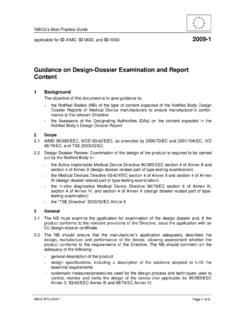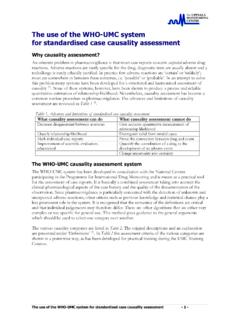Transcription of User guide for micro, small and medium-sized enterprises
1 User guide for micro, small and medium-sized enterprises on the administrative and procedural aspects of the provisions laid down in regulation (EC) No 726/2004, that are of particular relevance to SMEs An agency of the European Union User guide for micro, small and medium-sized enterprises on the administrative and procedural aspects of the provisions laid down in Regulation (EC). No 726/2004, that are of particular relevance to SMEs SME Office Addressing the needs of small and medium-sized enterprises Latest revised version July 2016. EMA SME USER guide . Table of contents 1. 8. O. btaining a marketing authorisation within the European Union .. 8. European Union marketing authorisation the centralised 9. National marketing authorisations national, mutual recognition & decentralised 9.
2 Overview of (data) requirements for obtaining marketing authorisation in the EU legislative framework for 10. Implementation of adopted Upcoming legislative 2. SME 15. 16. Definition of an 16. Role of the SME 16. Incentives for SMEs (EU provisions and national provisions).. 16. Incentives offered by 16. Other EU incentives for 19. National provisions for 19. How to request SME 19. Assignment of SME 19. Newly established or non-EEA 20. Maintenance of SME 20. 3. SUPPORT TO MEDICINAL PRODUCT DEVELOPMENT ..23. Innovation task force (ITF).. 24. PRIority MEdicines (PRIME) scheme (human medicines only).. 24. Advanced therapy medicinal products (ATMPs) .. 24. Classification procedure as an 24. Certification for 25. Scientific advice/protocol 25.
3 Scope of scientific 25. Fee reductions for scientific 26. Scientific guidelines and position 27. 3. 4. MEDICINAL PRODUCT DEVELOPMENT (HUMAN)..29. 30. Active substance (drug substance).. 30. Finished product (drug product).. 33. Other specific 34. Non-clinical 34. 35. Pharmacokinetics & 35. Toxicology & Toxicokinetics .. 35. Clinical 37. Human pharmacology studies (phase I).. 37. Therapeutic exploratory studies (phase II).. 37. Clinical efficacy and safety (phase III).. 37. Therapeutic use/clinical utility (traditionally phase IV).. 38. Adaptive 38. Clinical trials notice to applicants .. 38. Measures for orphan 40. Paediatric 41. GMP/GDP/GCP/GLP .. 43. Good manufacturing practice (GMP).. 43. Good distribution practice (GDP).. 44. Good clinical practice (GCP).
4 44. Good laboratory practice (GLP).. 44. 45. 5. MEDICINAL PRODUCT DEVELOPMENT (VETERINARY) ..47. aximum residue limits (MRL) .. 48. M. Quality .. 49. Safety .. 49. Efficacy .. 49. Immunologicals .. 50. GMP/GDP/GLP/GCP .. 50. MUMS/limited market 50. 4. EMA SME USER guide . 6. APPLICATION FOR CENTRALISED MARKETING AUTHORISATION ..53. Access to the centralised 54. Selection of 54. (Invented) Name of products evaluated via the centralised 55. EMA contact point in the centralised 55. EMA pre-submission 57. Compilation of the application 57. Submission and validation of the application 58. Evaluation of the 58. Re-examination of the CHMP/CVMP 60. Conditions to the marketing 60. Post-authorisation efficacy studies (PAES).. 60. Publication of clinical data for medicinal products for human use ( policy 0070').
5 61. Decision-making 61. Early access to the EU market .. 62. Accelerated assessment .. 62. Conditional marketing authorisation (human medicines only).. 62. Compassionate 63. Marketing authorisation under exceptional 63. Adaptive 63. Marketing of a centrally authorised product in the Union .. 64. 7. RISK MANAGEMENT AND PHARMACO G ood pharmacovigilance practices (GVP).. 68. Key aspects of the current EU pharmacovigilance 69. Reporting obligations .. 71. Sponsors of clinical trials reporting 72. MAHs of medicinal products authorised in EEA - reporting 73. 73. Pharmacovigilance for veterinary medicinal 74. 8. OTHER USEFUL INFORMATION ..77. Information on medicinal products .. 78. Contact points at ANNEXE 81. National provisions for SMEs applicable to the pharmaceutical 82.
6 94. 5. 1. INTRODUCTION. 1. INTRODUCTION. 1. Introduction O. btaining a marketing authorisation within This guide has been prepared for micro, small and me- dium-sized enterprises ( SMEs') operating in the phar- the European Union maceutical sector. Its aim is to facilitate understanding Prior to marketing a medicinal product2 in the EU, a of the main aspects of medicinal product legislation. marketing authorisation (product licence) must be The guide is structured to follow the chronological stag- obtained. The company who holds the authorisation to es of developing a medicinal product. An overview of place the medicinal product on the market and who is the scientific data requirements for obtaining a market- legally responsible for marketing the medicinal product ing authorisation in the European Union ( EU') is pro- (so-called marketing authorisation holder'), must be vided.
7 The regulatory procedures in place to optimise established 3 within the EEA (Iceland, Liechtenstein, development and obtain an EU marketing authorisation Norway and the Member States of the European Union). are also summarised. In the EU, there are two types of marketing authorisation: The guide focuses primarily on the requirements for authorising medicinal products for human or veterinary use. The guide is not intended to be an exhaustive document but rather to raise SMEs' awareness of the National marketing various more detailed sources of information available. authorisations: issued by the competent authori- In December 2005, Commission Regulation (EC) No ties of individual Member States. 2049/20051 ( SME Regulation') introduced provisions The medicinal product may be aimed at promoting innovation and the development put on the market in all Member States that have granted an authorisation for it.
8 Of new medicinal products for human and veterinary use by SMEs. This guide is intended to fulfil the obli- OR. gation laid down in Article 12 of the SME Regulation, which calls on the European Medicines Agency ( EMA'. or Agency') to publish a User guide ' on the adminis- trative and procedural aspects of medicines legislation which are of particular relevance to SMEs. European Union marketing authorisation: Pursuant to the SME Regulation, companies can ac- granted by the European cess financial assistance (in the form of fee reductions Commission, following a positive and deferrals) and administrative assistance from the opinion from the Agency. This is Agency, details of which are outlined in section 2 of this a single authorisation that allows guide .
9 To facilitate contact with the Agency, a SME Of- the medicinal product to be put on the market fice' was launched in December 2005 and is dedicated to in all Member States. addressing the particular needs of smaller companies. Any feedback on the content or format of this guide should Approved conditions of use are laid down in the sum- be forwarded to the SME office: mary of product characteristics4 (prescribing informa- tion for health professionals), the labelling and the package leaflet for users5. This user guide will focus on the use of the centralised procedure for obtaining an EU marketing authorisation. Further information on the regulatory routes for obtaining national marketing authorisations, namely the mutual 1. ) :L:2005:329:0004:0007:EN:PDF.
10 2. ) A medicinal product for human use or a veterinary medicinal product is defined in Directive 2001/83/EC of the European Parliament and of the Council of 6 November 2001 and Directive 2001/82/EC of the European Parliament and of the Council of 6 November 2001. 3. ) Being established shall be understood as having a permanent legal structure (formed in accordance with the law of an EU Member State or other EEA country). That allows the concerned person to assume the duties and responsibilities as well as to perform the tasks laid down by Union law. For reference on establishing see point 2 of Chapter I, Vol. 2A (human medicines) or 6A (veterinary medicines) of the Notice to Applicants: 4. ) In accordance with Article 11 of Directive 2001/83/EC for human medicines and Article 14 of Directive 2001/82/EC for veterinary medicines.














